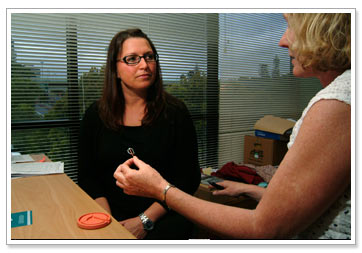Intrauterine contraception IUDs and IUS
We have already talked a little about the Copper IUD in NZ - the Copper T T 380 . This is a T shaped plastic device with copper on the stem and on each horizontal arm -when you have your Family Planning visit ask them to show you what it looks like. The copper in the stem and on the arms of the device kills sperm and so the main mode of action is as a contraceptive , stopping the sperm and the egg meeting. However it does have a back up mode of action as an interceptive . If sperm were to get past the IUD and fertilise an egg , then that fertilized egg cannot implant so avoiding pregnancy. This mode of action is an interceptive and this is how a copper IUD works when used postcoitally.
Somehow there is still the perception out there that young women or women who have not had children should not use an IUD.This is not correct. Have a look at your UK Medical Eligibility Criteria for Contraceptive Use summary.
This may have come from a concern that IUDs cause pelvic infection -this is not the case as the majority of infections are due to STIs such as chlamydia. The woman may be using the IUD for contraception but we do not have any research that tells us that with the IUD in situ she is more likely to get an ascending infection than if she was not using one. So, as with other contraceptive methods, women using an IUD need to use condoms with a new partner until he has had an STI check.
You can see from the UK Medical Eligibilty criteria that indeed if a woman has an IUD in situ and gets PID -we dont take the IUD out -we treat with antibiotics in the usual way -and only if no response would we remove the IUD.
However the situation may be different- if she already had a positive chlamydia and we then inserted an IUD without treating it first -then we could increase the possibility of "pushing " the infection further up and causing PID. So - do we, as a routine, do STI checks before IUD insertion?--no - not usually for women in a stable relationship -but useful to do where there may have been recent partner change.
You will see from the UK Medical Eligibility Criteria that for young women from menarche to age 20 the criteria for IUD use is 2-Generally use the method
We have said that Cu IUDs need replacing 10-yearly. However, if they are inserted in women over the age of 40, they can then be left in place till one year after menopause and if this was at age 50+ then contraception will no longer be required. Remember though that if women have had their last period under the age of 50 they will require contraception for the next 2 years.
It is important that women are taught to feel for the IUD strings as a way of checking that the device is still in place. Strings sometimes get pulled up into the cervical canal, in which case gentle probing with some sinus forceps can help to tease them back down. If no strings are found the woman will need to have a pelvic ultrasound to make sure the device is in good fundal position. If this is the case it can be left in place until renewal is necessary. The device will then need to be taken out using crocodile forceps in a specialized IUD clinic. Where USS does not show the device to be in utero, a follow up pelvic Xray is necessary to ensure that perforation has not occurred.
 Reading
Reading
While you are reading the IUD references from the Faculty of Sexual and Reproductive Health Care site start thinking about the use of a copper IUD as a postcoital contraceptive as we will be talking about post coital or emergency contraception later.
The copper IUD as a postcoital method
 Case study: Sophia
Case study: Sophia
Sophia and her partner have been using condoms for contraception. She visits you at your practice today, Wednesday, for advice about emergency contraception as they had a broken condom on Saturday. She usually also charts her cycle which is regular 26 days and tells you she is day 16 today. She knows that she is probably too late for the emergency pill but has heard that an IUD can be put in as a post coital method.
One of the reasons that this appeals to her is that she would like to change from condoms and thought that she would like to keep it in as her contraceptive method. When inserting an IUD as a postcoital method it must be placed in the uterus up to and before 5 days after fertilization ie 5 days after likely ovulation. Fertilised eggs take 7 days to come back along the tube from the fimbrial end to implant so this ensures that the fertilized egg is not already implanted in the uterus. The IUD will then stop implantation from happening.You agree that it would be appropriate to fit a postcoital IUD for Sophia.

 Activity
Activity
Answer true or false to the following statements:
| « Depo Provera | Jadelle » |



